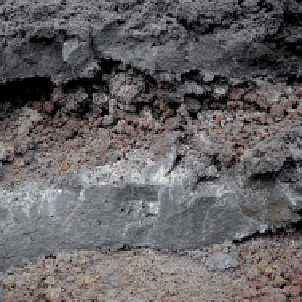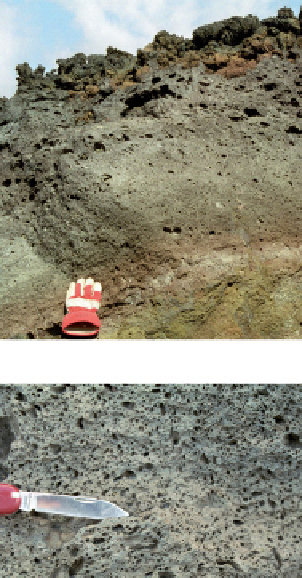Geoscience Reference
In-Depth Information
•
Flow architecture.
Did the fl ow arrive in place with the full
thickness you now see, or was it 'infl ated' by a series of
pulses? Look for signs internal to the fl ow bearing on this
matter, but also study the fl ow top. If you can fi nd either
pahoehoe texture or several-metre-high mounds that may
have been tumuli, then the fl ow probably grew by infl ation,
implying a relatively slow but prolonged effusion rate.
7
•
Vesicles.
Concentrations or layers of vesicles within a fl ow
(Figure 7.12) may record pauses in infl ation of the fl ow.
Non-spherical vesicles may indicate either shearing during
fl ow or later fl attening. Vesicles in general, especially if
concentrated towards the top, are a good indicator of a lava
fl ow rather than a sill. Mineral infi ll of vesicles (turning
them into amygdales) is a consequence of post-
emplacement fl uid percolation. Identifying these minerals
may help to defi ne metamorphic grade (Section 9.3).
50 cm
Figure 7.11
The side of a
road-cutting exposing the massive
interiors and rubbly tops of 'a'a
fl ows in Hawaii. (David A. Rothery,
The Open University, UK.)
Vesicles in lava and in volcanic bombs can preserve a record of
the history of bubble nucleation and expansion in the magma
(e.g. Worked Example 7.1, p. 148). This may have occurred in
several stages (e.g. during ascent, during storage at depth,
during ejection from the vent, after emplacement). In the fi eld,
use your eyes and brain to weigh up the possible information
conveyed by vesicles, but be aware that thorough analysis of
the size distribution of bubble populations requires
measurements in the laboratory (based on measuring large
numbers of bubbles, often in thin-section).
Lava fl ows too thin to develop columnar jointing tend to have a
massive interior but sometimes a rubbly base. In basalts, the
top will be especially rubbly if the fl ow was emplaced as an
'
a
'
a (Figure 7.11). If emplaced as pahoehoe, it may be possible
to fi nd distinctive relicts of pahoehoe lobes or ropes on the
upper surface. A thin fl ow is unlikely to pass from subaqueous
to subaerial, so if there are pillows the whole fl ow is probably
subaqueous (Figure 7.14, p. 149), a defi nition which includes
eruption under ice.
(a)
Chilling and chilled margins
A minor intrusion such as a dyke or a sill is likely to have been
emplaced at a fairly shallow depth into relatively cold country
rock. You should therefore expect to fi nd its grain size
decreasing close to the contact, forming a 'chilled margin'.
Figure 7.12
Vesicles within an 'a'a lava fl ow, seen in cross-section.
(a) General view, showing how vesicles become larger towards the top of
the fl ow. (b) Close-up within the grey, central, part of the fl ow revealing
that millimetre- and centimetre-scale vesicles are very abundant. Mount
Etna, Italy. (a and b: David A. Rothery, The Open University, UK.)
(b)












